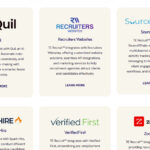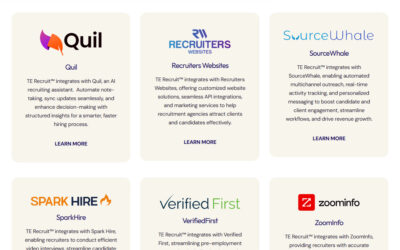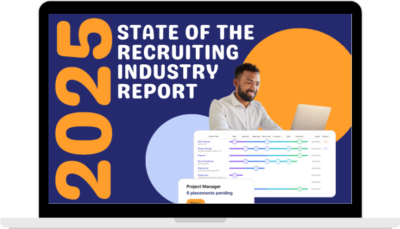Every recruiter is staring down a big question in 2025: What matters most right now? After a few years of whiplash-inducing shifts—COVID surges, hiring frenzies, economic cooling, AI disruption, and now tariff tremors—the recruiting industry is recalibrating.
In our annual State of the Recruiting Industry Survey, asked recruiters directly: What is your highest business priority for 2025? Their answers were honest, strategic, and sharply focused.
Top Business Priorities for 2025
- Getting search assignments from new clients – 32.50%
- Finding new clients – 26.88%
- Adding new income streams – 14.38%
- Getting more search assignments from current clients – 12.50%
- Sourcing higher quality candidates – 8.13%
- Recruiting in a new niche – 5.63%
This isn’t just a list—it’s a pulse check on where recruiters are directing their energy. Let’s break down what each priority means and explore what recruiters had to say about the year ahead.
1. The Chase for New Business: A Sign of the Times
At the top of the list: getting search assignments from new clients and finding new clients. Combined, that’s nearly 60% of all responses.
“In 2025, my focus is on deepening relationships with existing clients and becoming even more of a go-to partner for their hiring needs. There’s still opportunity on the table, and building trust to secure more consistent search work is the biggest priority.”
This shift reflects current market dynamics. Many recruiters have seen a pullback in volume or commitment from existing clients, requiring a fresh push into new accounts to maintain momentum.
“Fee-paying clients. That’s the biggest priority. Too many companies aren’t paying fees right now.”
“Finding new clients and getting more search assignments from current clients—really, all of the above.”
Recruiters understand that while nurturing current relationships is important, growth comes from outbound energy. But in a post-2024 market that’s still jittery from inflation, interest rate spikes, and recession fears, that pursuit takes more time—and more finesse.
2. Expanding Offerings: New Income Streams in a Tight Market
With 14% of recruiters prioritizing adding new income streams, many are looking beyond traditional placements.
“We’ve just started our resume and executive coaching services through the Higher Network and Higher Talent Group to help employed and unemployed candidates do better at interviewing and getting their dream job.”
“I’ve shifted slightly to healthcare to help the income stream. I still focus on biotech but have been adding healthcare. The TE Network made this possible—splitting fees with other recruiters in unfamiliar spaces has been wonderful.”
Diversification is proving to be a survival strategy. Resume writing, coaching, HR consulting, and offering add-on services are helping recruiters remain relevant even as traditional placement fees shrink.
One respondent captured the mindset of this moment well:
“Pretty much all of the above.”
3. Sourcing High-Quality Candidates: A Growing Challenge
Even in an uncertain economy, 8% of recruiters are focused squarely on one thing: candidate quality. Why? Because client expectations haven’t gone down—even if hiring budgets have.
“Sourcing more appropriate candidates. Finding enough candidates. That’s the issue.”
“Clients are picky. Good candidates aren’t open. Bad candidates are open but there’s nowhere to place them.”
This paradox—more job seekers, but fewer placeable candidates—has been frustrating. Especially in high-touch niches, recruiters are still expected to deliver gold, fast, even as talent is increasingly passive or skeptical.
“It’s a buyer’s market, but that doesn’t mean the talent is always right for the role. Clients don’t want to pay a fee unless the match is flawless—and that’s getting harder.”
AI and automation are speeding up sourcing but also increasing noise—and experienced recruiters know that volume doesn’t equal value.
4. More from Existing Clients: A Smart Strategy for Stability
12.5% of respondents are looking inward—prioritizing getting more search assignments from current clients. These recruiters are playing the long game, banking on relationship depth to deliver growth without the same energy investment of net-new sales.
“All my work is relationship-based.”
“Expanding my niche into sub-niches. There’s more opportunity when you understand a client’s business deeply.”
This priority is particularly common among recruiters with longer client histories or niche specializations where trust and consistency are hard to replace.
“In 2025, I’m leaning on my long-term relationships. My clients know my value. Now it’s about showing how that value applies across more of their hiring needs.”
Others are using a split model—continuing to hunt while making sure existing clients don’t drift away.
“Finding new clients and getting more assignments from current ones. All of the above.”
5. Recruiting in a New Niche: A Minority Strategy, but a Strategic One
Only 5.6% said recruiting in a new niche was their top priority—but those who did are making moves for strategic reasons, not desperation.
“I’ve been able to shift into horizontal construction after 20 years in vertical construction, which is now being hit hard by tariffs. Thankfully, I had experience there early in my career and relationships to tap into.”
Others are exploring adjacent markets, often by splitting fees with more experienced partners in those spaces.
“I added healthcare to my biotech focus—it’s a related field, and TE Network connections helped make the leap feel doable.”
“I’m expanding my niche into sub-niches. That’s where I see potential.”
Shifting into new markets takes time and risk—but for those dealing with unstable industries or pricing pressure, reinvention is a survival tool.
6. The Quiet Truth: Life and Career Transitions
Some responses didn’t fall neatly into a survey category—but they still tell an important story.
“I’m near the end of my career and winding down. My priority is to earn a moderate level of income while working part time and transition my business into another recruiter’s business.”
“I’m semi-retiring while keeping up a moderate income stream.”
“I’m retiring at the end of May after 30 years. I really believe the current economic policies are hurting small businesses. Very sad and scary.”
These voices reveal a cohort of seasoned recruiters who are gracefully exiting or stepping back after decades in the game. They carry institutional memory, networks, and hard-won wisdom—but they’re also deeply aware that the industry is changing.
“All this technology and automation is great—but it’s not making recruiting better. It’s making it faster. That’s not the same thing.”
Final Thoughts: Where the Industry is Headed Next
If 2024 was the year of waiting and worrying, 2025 is shaping up to be a year of targeted action. Whether it’s finding better clients, deeper relationships, or broader income streams, recruiters are getting clear on what will move the needle.
Here’s what the data and commentary reveal:
- Client development is king. Whether it’s new logos or more from old ones, recruiters know they need business before anything else matters.
- Diversification is no longer optional. Coaching, consulting, and resume work aren’t distractions—they’re insulation against volatility.
- The candidate experience still matters. The ability to find, engage, and place great people remains the core product.
- Relationships remain the moat. Trust, follow-through, and understanding a client’s unique challenges can’t be commoditized or outsourced.
- And above all else—adaptability wins.
“I’ve been able to be nimble after 30 years in the business, thankfully. That’s what it takes now.”
Recruiting in 2025 isn’t for the passive, the generic, or the outdated. It’s for those willing to lean in, sharpen their positioning, and find creative ways to thrive—even in a market that’s still finding its footing.
And if this survey tells us anything, it’s that the recruiting industry isn’t just surviving. It’s recalibrating.









